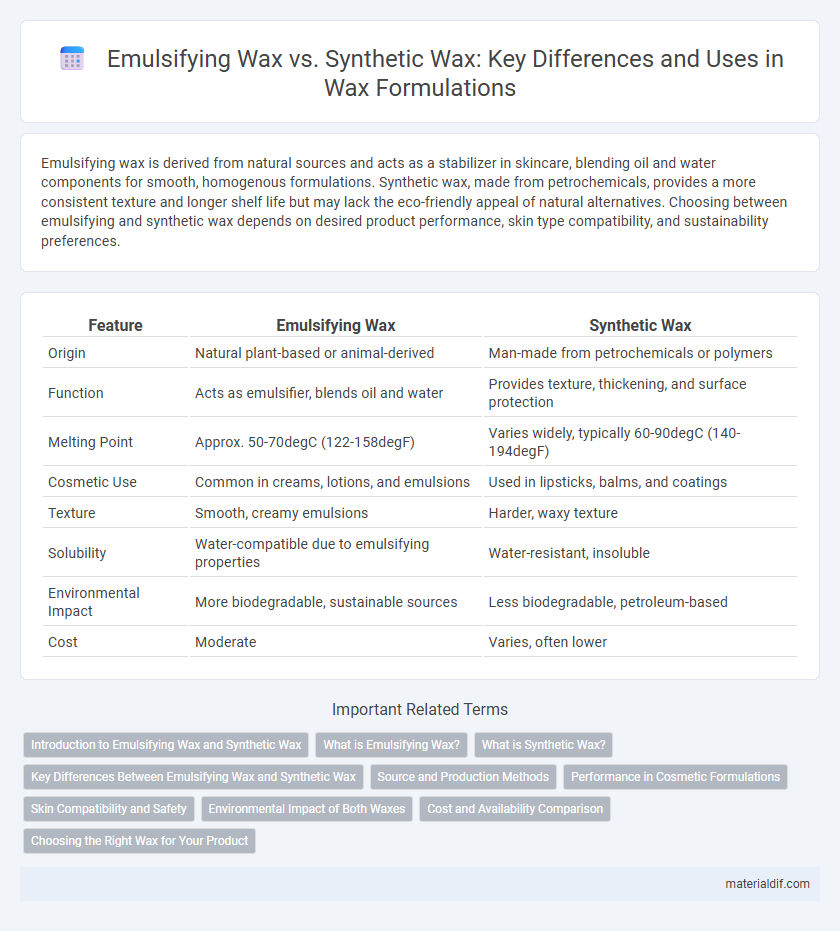Emulsifying wax is derived from natural sources and acts as a stabilizer in skincare, blending oil and water components for smooth, homogenous formulations. Synthetic wax, made from petrochemicals, provides a more consistent texture and longer shelf life but may lack the eco-friendly appeal of natural alternatives. Choosing between emulsifying and synthetic wax depends on desired product performance, skin type compatibility, and sustainability preferences.
Table of Comparison
| Feature | Emulsifying Wax | Synthetic Wax |
|---|---|---|
| Origin | Natural plant-based or animal-derived | Man-made from petrochemicals or polymers |
| Function | Acts as emulsifier, blends oil and water | Provides texture, thickening, and surface protection |
| Melting Point | Approx. 50-70degC (122-158degF) | Varies widely, typically 60-90degC (140-194degF) |
| Cosmetic Use | Common in creams, lotions, and emulsions | Used in lipsticks, balms, and coatings |
| Texture | Smooth, creamy emulsions | Harder, waxy texture |
| Solubility | Water-compatible due to emulsifying properties | Water-resistant, insoluble |
| Environmental Impact | More biodegradable, sustainable sources | Less biodegradable, petroleum-based |
| Cost | Moderate | Varies, often lower |
Introduction to Emulsifying Wax and Synthetic Wax
Emulsifying wax is a natural or semi-synthetic compound designed to blend oil and water phases in cosmetic formulations, ensuring smooth texture and stability. Synthetic wax, derived from petrochemicals, offers consistent quality and enhanced performance such as higher melting points and improved shelf life in personal care products. Both waxes play crucial roles in product formulation, but emulsifying wax is preferred for its eco-friendly attributes and skin compatibility.
What is Emulsifying Wax?
Emulsifying wax is a natural or semi-synthetic ingredient derived from fatty alcohols and vegetable oils, designed to blend oil and water in cosmetic formulations. It stabilizes creams, lotions, and other emulsions by creating a uniform texture and preventing ingredient separation. Unlike synthetic waxes, emulsifying wax enhances product spreadability and skin absorption, making it ideal for skincare products.
What is Synthetic Wax?
Synthetic wax is a man-made substance created through chemical processes such as polymerization, designed to mimic the properties of natural waxes like beeswax or carnauba. It offers consistent melting points, enhanced durability, and customizable characteristics for various industrial and cosmetic applications. Synthetic waxes improve product texture, stability, and water resistance compared to their natural counterparts.
Key Differences Between Emulsifying Wax and Synthetic Wax
Emulsifying wax is a plant-based or natural ingredient used primarily to blend oil and water components in cosmetic and skincare formulas, enhancing product texture and stability. Synthetic wax, on the other hand, is chemically manufactured, offering consistent melting points and durability but lacking skin-friendly properties found in natural emulsifying waxes. The key differences lie in their origin, functional roles in formulations, and their impact on the final product's texture and skin compatibility.
Source and Production Methods
Emulsifying wax is derived from natural sources such as vegetable oils and fatty alcohols, produced through a chemical process called ethoxylation that enhances its ability to blend water and oil; it is widely used in cosmetics for its skin-friendly properties. Synthetic wax, on the other hand, is manufactured from petrochemical sources through polymerization or Fischer-Tropsch synthesis, resulting in uniform molecular structures and tailored melting points. This distinction in source and production methods influences the environmental impact, texture, and application of each wax type in various formulations.
Performance in Cosmetic Formulations
Emulsifying wax delivers superior stability and texture in cosmetic formulations by effectively blending oil and water phases, resulting in smooth, consistent creams and lotions. Synthetic waxes often offer enhanced control over viscosity and melting points, allowing formulators to tailor product performance to specific skin types and sensory preferences. Overall, emulsifying wax enhances emulsion integrity, while synthetic wax optimizes formulation flexibility and durability.
Skin Compatibility and Safety
Emulsifying wax, derived from natural vegetable oils, offers superior skin compatibility and is less likely to cause irritation, making it ideal for sensitive skin formulations. Synthetic waxes, often produced from petrochemicals, may provide a stable texture but can sometimes trigger allergic reactions or clog pores, reducing overall skin safety. Choosing emulsifying wax enhances skin hydration and barrier protection, supporting safer and gentler cosmetic products.
Environmental Impact of Both Waxes
Emulsifying wax, derived from natural vegetable oils, offers greater biodegradability and lower toxicity, reducing environmental pollution during production and disposal compared to synthetic wax made from petrochemicals. Synthetic wax often involves energy-intensive manufacturing processes that generate higher greenhouse gas emissions and contribute to fossil fuel depletion. Choosing emulsifying wax supports sustainable practices by minimizing ecological footprint and promoting renewable resource use.
Cost and Availability Comparison
Emulsifying wax, derived primarily from plant-based sources, tends to be more expensive due to its natural composition and eco-friendly appeal, while synthetic wax is generally more cost-effective and widely available because it is manufactured using petroleum-based materials. The availability of synthetic wax is higher in mass markets due to large-scale production, whereas emulsifying wax might have limited supply chains, especially in regions prioritizing natural ingredients. Businesses looking for cost efficiency typically prefer synthetic wax, whereas brands emphasizing sustainability often invest in emulsifying wax despite its higher price point.
Choosing the Right Wax for Your Product
Emulsifying wax primarily consists of natural fatty alcohols and fatty acids, ideal for creating stable oil-in-water formulations like creams and lotions due to its excellent blending properties with both water and oils. Synthetic waxes, often made from polyethylene or other polymers, provide superior durability and water resistance, making them suitable for products requiring a longer-lasting finish, such as lip balms and industrial applications. Selecting the right wax hinges on your product's purpose: opt for emulsifying wax for smooth, easily absorbed skincare formulations, while synthetic wax offers enhanced structural integrity and moisture barrier benefits.
Emulsifying Wax vs Synthetic Wax Infographic

 materialdif.com
materialdif.com